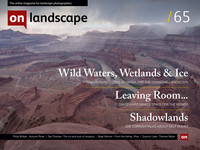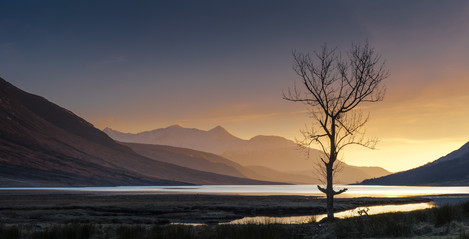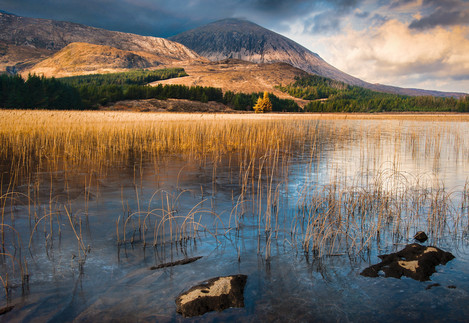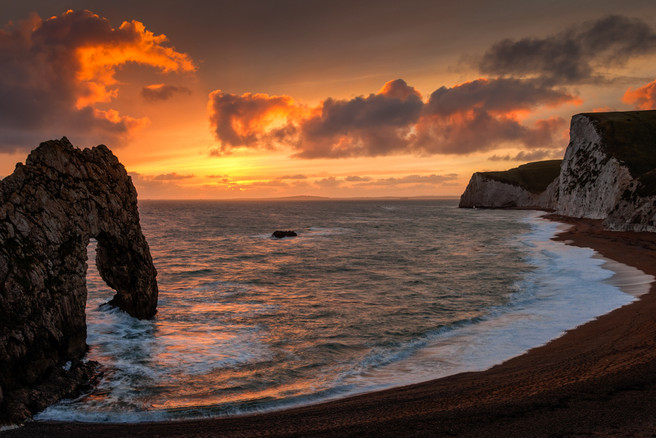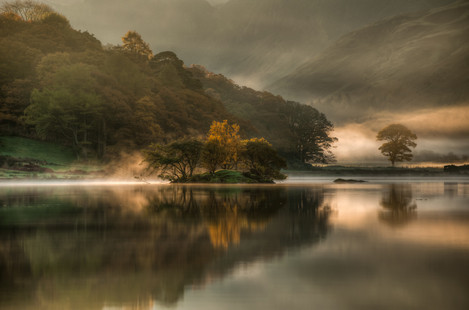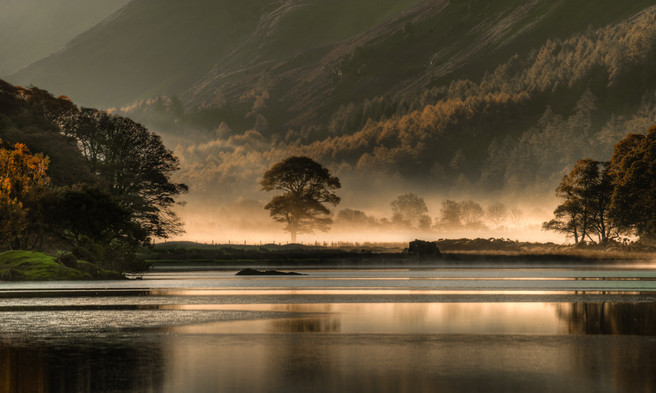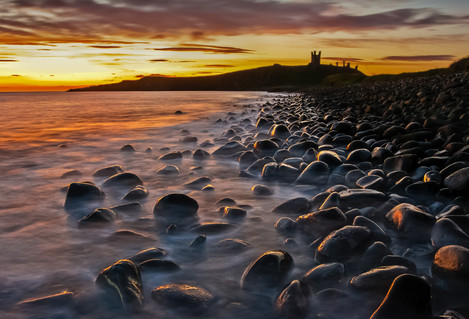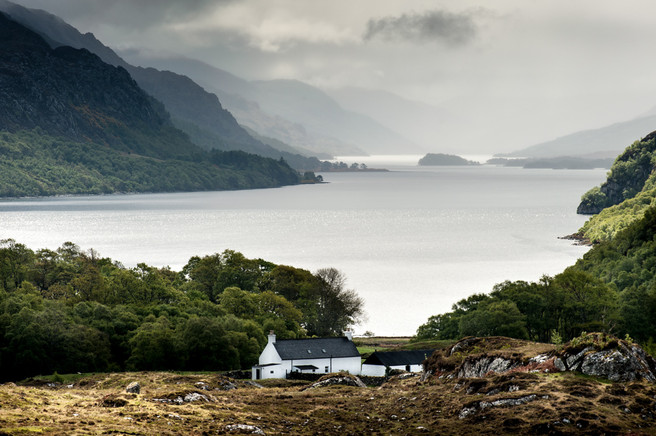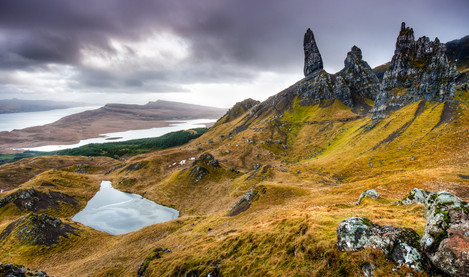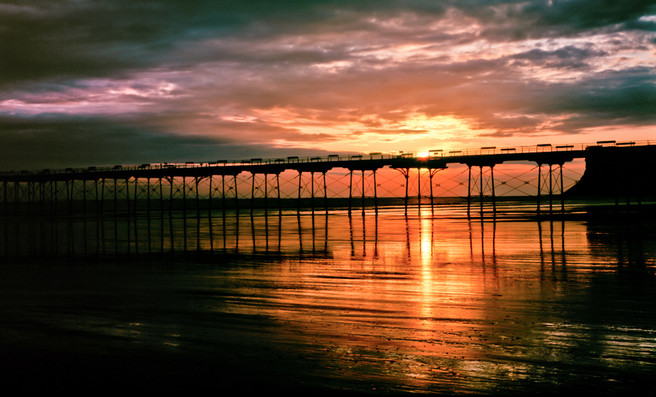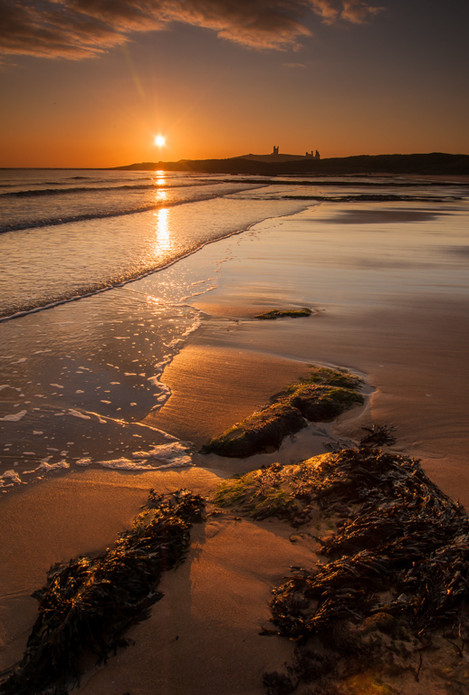Winner of Landscape Photographer of the Year 2013

Doug Chinnery
I am an artist working with images full of colour and movement in an attempt to express what I see around me. Inspired by artists, in particular the impressionists and abstract impressionists as well as Chris Friel and Valda Bailey, I work in abstraction trying to capture mood and emotion. I live in obscurity with my wife, Beth, and my buddy, Eddie.
The Landscape Photographer of the Year competition (or Take a View) has reached completion and the winners announced and we're happy to say, without any major controversy. Tony Bennett took the overall prize with a beautiful, misty photograph of Crummock Water (click the image below for a larger version).
Doug Chinnery has had Tony Bennett as an attendee on one of his workshops in the past and took the opportunity to get back in touch to ask a few questions for us. A short version of this interview is available on Doug's website but he asked a few extra questions for On Landscape and Tony has given us a few more images to use.
Doug Chinnery: First of all, let me congratulate you on your wonderful success in winning LPOTY 2013. Your image is stunning and a deserved winner. How did you feel when you heard you had won?
Tony Bennett: I was totally overwhelmed. Charlie Waite phoned me whilst I was in the car and the next mile passed as a blur. It was beyond my most optimistic hope. It took several days for the realisation to dawn upon me that i had actually won. I knew my image was good, but being good is not enough; you have to hope that the judges not only think it is good, but the best. That is the difficult part. And I knew that many very good photographers had entered the competition with some truly excellent images.The competition was fierce.
D: Can you describe the morning when you made the image?
T:That morning was just magical; one of those mornings that happen so infrequently but are always remembered. With a friend, Sarah, we left the hotel early and raced to the lake side. The dawn was just beginning to break. We set up our tripods at the water's edge and for the next hour and a half, just captured as many images of the ever-changing scene as we could. Did I say it was magical? It was. We eventually had to get back to the hotel for a late breakfast, but by that time the real mood of the scene had changed to mere normality, the mist had virtually gone, the sun was up and the lake surface was disturbed - no longer the glassy mirror it had been.
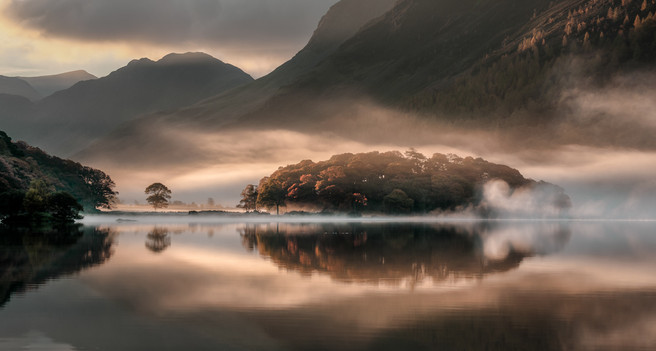
D: Have you entered LPOTY before (and if so, had any previous successes) or was this your first time?
T: No. This was my first time.
D: What moved you to submit an entry this year?
T: I have been entering several BPE exhibitions this year, with some success, and thought I had some images that might be acceptable to LPOTY – and acceptable is as far as my expectations went!
D: How did you go about selecting the images you entered? and how many did you enter? How many were shortlisted?
T: I looked at my images taken over the last 4 years that I considered were both instantly striking and had an atmospheric mood that might hold the viewer’s attention. These were quite varied in tone and mood and so offered a variety that I thought might appeal to the judges. I entered 6 out of my shortlist of 14. Just one was shortlisted by LPOTY.
D: Why do you think entering competitions like LPOTY is a good thing for photographers and photography?
T: These competitions offer a challenge to photographers to produce their very best work. All too often, our images stay on the hard drive and don't get the finishing attention they should. When you enter a competition, you owe it to yourself to offer the very best you can. This can take time and effort, but sometimes, as in my case, it proved worth every effort, including that early morning start.
D: Have you always been interested in photography? What is your photographic 'history'?
T: I have been interested in photography since my 20's. (I am now well retired!). I have spent many hours in the darkroom trying to produce the 'perfect' B&W print, without success! I have also done some wedding and industrial photography back in the film days, but my first love has always been landscape images. Up to this time, I have only entered club competitions and our local N&EMPF annual competitions. This is the first 'real' external competition that involved a prizes. (memo to self: must enter more!)
D: who would you say was your first inspiration in photography? And who do you find inspirational now?
T: I can't remember anyone initial inspiration that has driven my photography. Today, undoubtedly, Sebastiao Salgado I find truly inspirational.
D: What does photography do for you? What do you get out of it that drives you to pursue it as a passion?
T: I love the great outdoors and capturing beautiful images.
D: What camera equipment do you currently use?
T: I currently use a Nikon D700 with the 16-35mm lens, and the 24-120mm lens. For the winning image I used my 70-200mm lens; that lens trio, plus an old macro lens, covers all my photographic needs. Recently I have bought an Olympus EM-5 and found it to be very useful on a recent trip to Venice on the hottest day of 2013! It was light and easy to carry and produces pretty decent images that can be enlarged to about A3 size.
D: Is there a piece of kit you really couldn't live without? A favourite piece of equipment?
T: Strangely, it is my very sturdy and stable tripod.
D: Is there any piece of equipment you lust after and would love to own?
T: I would love to have a Nikkor 24mm tilt shift lens.
D: I know you are a keen and active member of the Derby City Photographic Club. What do you enjoy about being part of a photography club?
T: I enjoy club photography for the personal friendships I have made and my friends' support for my photography. (They are always there with honest criticism!) I also relish the challenges the competitions offer. Our Club is a great social as well as a photographic club. We have excellent speakers who challenge, stimulate and entertain.
D: Would you describe yourself as a "Landscape Photographer" or do you enjoy other genres of photography?
T: I have done studio portraiture, and wedding photography (many years ago). I like to think of myself as a landscape photographer. Perhaps I can, now!
D: What advice would you give to young or new photographers to help them make progress with their passion?
T: Join a camera club and GET INVOLVED. Don't just turn up, enjoy the proceedings, then go home. You only get out of any activity in proportion to what you are prepared to contribute.
D: What software do you use to process your images?
T: I use Lightroom primarily and use Photoshop for any post processing that can't be done in Lightroom. Topaz plugins are very useful to extend the scope of LR and PS. I also use Photomatix Pro for HDR images and Helicon Focus for focus stacking of macro shots.
D: I see you have a new website, Tony. For those who are keen to see your work, what is the URL?
T: www.inspirational-images.com (Don't forget the hyphen). It is my first website, put together in rather a hurry in view of my competition win. It is still a bit clunky, so please excuse that. It will be added to and improved as time goes on.
D: What are your plans now you have won the competition? And do you have any plans for spending your prize money?
T: The last few days have been rather hectic, but eventually, I guess, things will return to normal. I have no plans to spend the prize money at the moment. When things settle down I think I might just treat myself to a new lens, or camera, even.
D: You mention that Salgado's work inspires you. What is it about his images which affects you? Do you find it influencing the way you work now?
T: In my ‘library’ I have two of Salgado’s books: ‘An Uncertain Grace’, and ‘Africa’. My camera club, Derby City Photographic Club, has recently bought ‘Genesis’, his latest, and heaviest (?) book. Salgado’s images are so unlike anything I have ever photographed. The nearest I have come is of (well-fed?) beggars in India and Nepal. Many of Salgado’s images show humanity at its most vulnerable and raw hopelessness; they are heart-wrenching. Every image sends a message. My landscape work is the very opposite; in my images, I also try to capture the atmosphere of the scene before me, but an atmosphere that is both ‘safe’ and ‘comfortable’ as we are accustomed to in the western world. The only similarity is that I hope my images invoke a response in the viewer, but in my case, a warm response. On reflection, I think I’ve just defined what good photography is about: an image-based message invoking a reaction.
D: Can you tell us a little about your education and your introduction to photography?
T: I trained and qualified as a chemical engineer and worked in a variety of roles until retirement a few years ago. Serious photography started when I took City and Guilds courses in photography. They taught me the basics of the craft from both a technical and aesthetic viewpoint. In common with many other would-be photographers, I learnt darkroom skills but was also privileged to do some wedding photography (to help pay for my hobby). More recently, to escape from the all-singing-all-dancing digital cameras I had an urge to ‘get back to basics, which for me meant using a large format camera for which every setting is under the control of the photographer. It reminded me of the times I used a medium format Hasselblad for weddings; when every frame had to be right, first time, because repeats were just not possible.
D: Do you have any other interests aside from photography? Or does photography fill your spare time?
T: Photography occupies most of my spare time, but this also includes collecting old (real?) cameras of yesteryear, many of which I had owned (or wished I could have afforded) in the past. I also have an interest in historical slide rules and mechanical calculators.
D: Aside from winning LPOTY, what are you most proud of in your photographic career?
T: Difficult question as nothing comes remotely close. However, looking back, it must be the delighted looks on the faces of ‘my’ newly-weds when they first opened their wedding albums.
D: Can you recall any significant moments in your development as a photographer that really made a different to your photography?
T: Ansel Adams. The quality of his monochrome images amazed me and set the standard to which I once aspired in the darkroom – and even now in the Lightroom.
D: If we were to have a look in your camera bag now, what would we find? What do you carry with you into the field?
T: A Nikon D700 with 16-35mm, 24-120mm and 70-300mm lenses. When necessary, I also carry a 105mm microlens. And a Nikon flash. I also use a set of Lee ND grad filters, plus a 10-stop filter and polarizing filters. A tripod is a must-have. I spent years with ‘normal’ tripods which can cause more camera shake than they eliminate until I eventually invested in a heavy duty, but lightweight carbon fibre Feisol tripod for total rigidity and a Manfrotto geared head for precise composition.
D: Are you a photographer who likes to "get it right in camera" as much as possible, or do you do a lot of work in post processing? What can you tell us about your workflow in the filed and then back in the "digital darkroom"?
T: I do strive to get the image spot-on in camera. That certainly applies to composition as I like to crop as little as possible. As a landscape photographer, we are never in control of the light, only in control of how we capture and interpret the light. When possible I will use Grad filters to balance sky and foreground exposure, but all too often, the skyline is not conducive to grads, or there is a high dynamic range in the foreground, and in these circumstances, I am happy to bracket exposure and create an HDR image with Photomatix Pro. The challenge is to fool the viewer into believing it is not an HDR image because of the poor reputation such images have! My normal workflow starts, and often finishes, with Lightroom to balance highlights and shadows and adjust the white balance. I also sharpen in Lightroom. I will sometimes export to Topaz if I’m looking for special effects or want to convert to monochrome. For more extensive adjustment, Photoshop is used, but relatively infrequently.
D: Do you like to print your work? If so, how do you prepare it for print? What are your favourite papers? Do you print at home or do you have them done elsewhere, if so, where?
T: I enjoy printing my own images with my Epson 3800 printer. Mostly I print straight from the Lightroom Print module after soft proofing, using a printer profile custom-made for the paper in use. For colour work I have used many different papers, but my current favourite is Fotospeed PF Satin, or Permajet Ultra Pearl for a slightly different finish. For black and white prints, Ilford Gallerie Gold Mono Silk is superb, but again, for a rather different finish I have sometimes used Permajet Titanium Lustre.
D: Are there any books on photography, either "photobooks' or essay style books you have been inspired by and would recommend others to look at?
T: Working the Light, from Light and Land is a book of top-class landscape photographs which is sure to inspire. However, for something totally different I have a very rare book by the eminent Chinese photographer, Shao Jiaye, published by Liaoning People’s Publishing House (ISBN 7-205-02737-3/J.43). It is a slim volume of the most wonderful landscape images in the Chinese style. This was bought for me by a friend in China from a S/H bookshop and is perhaps the only copy in the UK. If you ever see one – just buy it!
- Tony Bennett – Overall Winner

